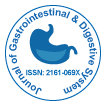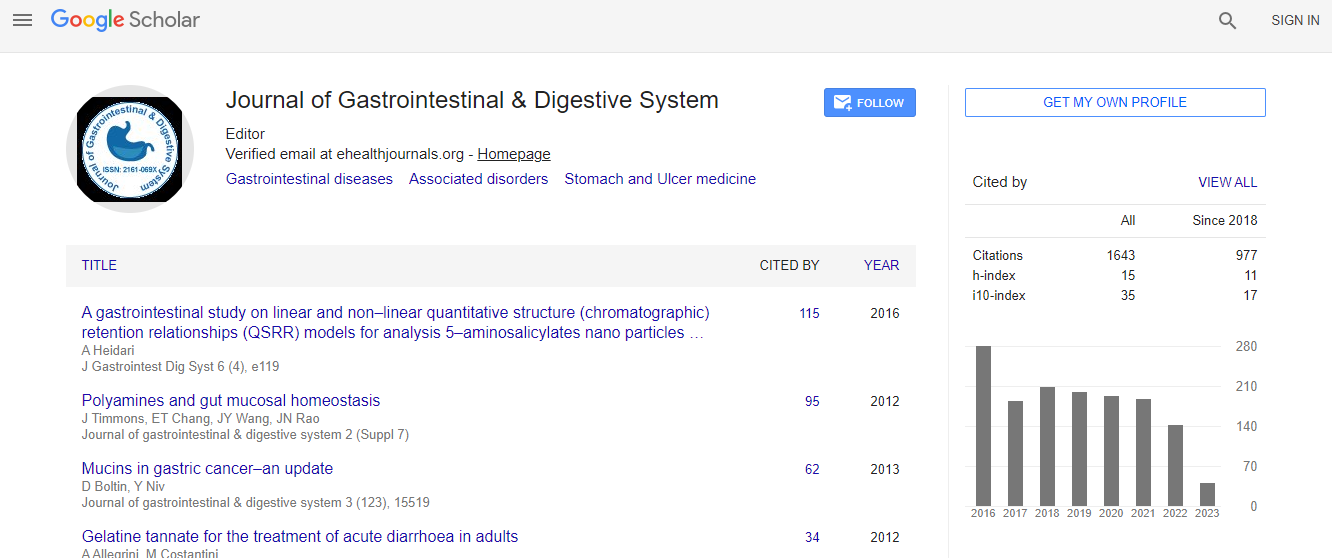Our Group organises 3000+ Global Conferenceseries Events every year across USA, Europe & Asia with support from 1000 more scientific Societies and Publishes 700+ Open Access Journals which contains over 50000 eminent personalities, reputed scientists as editorial board members.
Open Access Journals gaining more Readers and Citations
700 Journals and 15,000,000 Readers Each Journal is getting 25,000+ Readers
Google Scholar citation report
Citations : 2091
Journal of Gastrointestinal & Digestive System received 2091 citations as per Google Scholar report
Journal of Gastrointestinal & Digestive System peer review process verified at publons
Indexed In
- Index Copernicus
- Google Scholar
- Sherpa Romeo
- Open J Gate
- Genamics JournalSeek
- China National Knowledge Infrastructure (CNKI)
- Electronic Journals Library
- RefSeek
- Hamdard University
- EBSCO A-Z
- OCLC- WorldCat
- SWB online catalog
- Virtual Library of Biology (vifabio)
- Publons
- Geneva Foundation for Medical Education and Research
- Euro Pub
- ICMJE
Useful Links
Recommended Journals
Related Subjects
Share This Page
Long-term surgical outcomes of self-pulling and holding purse-string suture technique for intracorporeal circular-stapled esophagojejunostomy
Co-Organized Event 13th International Conference on Clinical Gastroenterology & Hepatology & 2nd International Conference on Digestive Diseases
Jianjun Du, Jianbo Shuang, Jing Li, Jipeng Li and Jin Hua
The Fourth Military Medical University, China Fudan University, China
ScientificTracks Abstracts: J Gastrointest Dig Syst
Abstract
Background: Classic esophagojejunostomy using a circular stapler is the most commonly performed standard reconstruction procedure in open surgery, then this technique should be the preferred method of esophagojejunostomy in laparoscopic surgery. In circular stapling method, the most difficult steps are placing the purse-string suture and anvil which limit its widespread applications. To address this problem, we introduced a novel self-pulling and holding technique to place the pursestring suture for intracorporeal circular-stapled esophagojejunostomy in laparoscopic surgery. Methods: Creation of the purse-string suture was performed by hand with assistance of constant self-pulling and holding of the uncut right esophagus on the transected esophageal end after subtotal circumferential transection (90%) of the distal esophagus. A needle insertion from the serosal side or the mucosal side of the esophageal lumen was chosen to avoid placing a backhand stitch in addition to the easy needle insertion from the mucosal side on the posterior esophageal wall. 5- years follow-up for the patients underwent the procedure was completed. Results: Between June 2009 and December 2012, 52 patients with gastric cancer underwent consecutive laparoscopic total gastrectomy using the procedure for intracorporeal circular-stapled esophagojejunostomy. The mean (├?┬▒SD) operating time was 297.1├?┬▒53.0 minutes, and the time of the purse-string suture and anvil placement was 18.3├?┬▒6.1 minutes. There were 3 major postoperative complications: one for anastomotic bleeding, two for ileus. During 5- years follow-up periods, there were no instances of postoperative anastomosis-related complications observed except for one with stenosis, Conclusions: We believe that this method is feasible and reliable to create the purse-string suture for intracorporeal circularstapled esophagojejunostomy by a long-term follow-up. Recent Publications 1. Jeong O, Park YK (2009) Intracorporeal circular stapling esophagojejunostomy using the transorally inserted anvil (OrVil) after laparoscopic total gastrectomy. Surg Endosc 23: 2624-2630. 2. Inaba K, Satoh S, Ishida Y, et al.(2010) Overlap method: novel intracorporeal esophagojejunostomy after laparoscopic total gastrectomy. J Am Coll Surg 211:e25-29. 3. Kinoshita T, Oshiro T, Ito K, et al.(2010) Intracorporeal circularstapled esophagojejunostomy using hand-sewn pursestring suture after laparoscopic total gastrectomy. Surg Endosc 24:2908-2912. 4. Nagai E, Ohuchida K, Nakata K, et al.(2013) Feasibility and safety of intracorporeal esophagojejunostomy after laparoscopic total gastrectomy: Inverted T-shaped anastomosis using linear staplers. Surgery 153:732-738. 5. Kim H-I, Cho I, Jang G-S, et al.(2013) Intracorporeal esophagojejunostomy using a circular stapler with a new pursestring suture technique during laparoscopic total gastrectomy. J Am Coll Surg 216:e11-16.Biography
Jianjun Du has his expertise in mini-invasive surgery in upper gastrointestinal disease, stomach disease. Within more than ten years. he has been keeping interested in stomach surgery, and in study on laparoscopy gastrectomy with some papers published, which suggest that laparoscopy gastrectomy for patients with advanced gastric cancer is surgical and oncological adequacy. Recently, to address problems in intracorporeal anastomosis under laparoscopic gastrectomy, two novel methods were also developed by his team.

 Spanish
Spanish  Chinese
Chinese  Russian
Russian  German
German  French
French  Japanese
Japanese  Portuguese
Portuguese  Hindi
Hindi 
